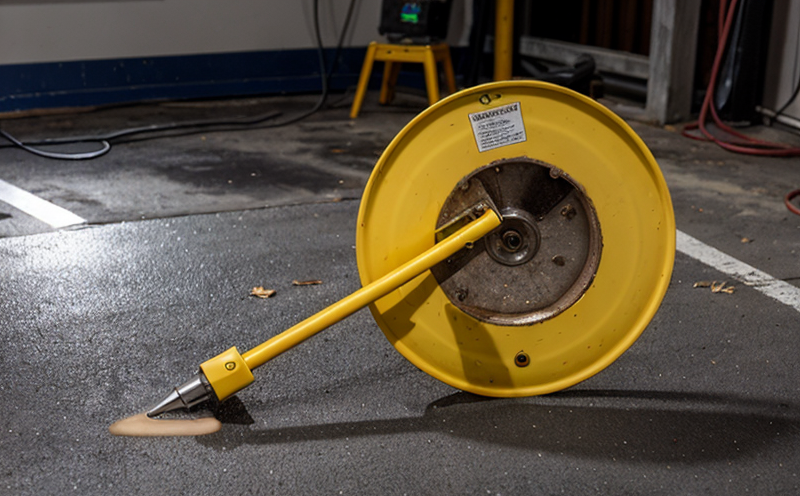ASTM E1742 Radiographic Testing of Welds and AM Components
The ASTM E1742 standard provides a detailed procedure for the radiographic examination of welds, additive manufacturing (AM) parts, and other components. This method is widely used in industries such as aerospace, automotive, petrochemical, and construction to ensure structural integrity by identifying internal defects that could compromise safety or performance.
The primary goal of ASTM E1742 radiographic testing is to identify flaws within the material without causing damage during inspection. The technique involves exposing the component to penetrating radiation (typically X-rays or gamma rays) and recording the resulting image on film or digital media. This process allows inspectors to detect imperfections such as cracks, porosity, incomplete fusion, and lack of penetration.
The testing procedure outlined in ASTM E1742 is rigorous and includes several key steps:
- Preparation: The component must be cleaned thoroughly to remove dirt, grease, or other contaminants that could interfere with the test results. Proper surface preparation ensures accurate imaging.
- Radiation Source Selection: Depending on the thickness of the material being inspected, appropriate radiation sources are chosen. Common choices include industrial X-ray machines and gamma ray generators using isotopes like Cobalt-60 or Ir192.
- Exposure Conditions: The exposure time and distance between the source and film are carefully controlled to produce clear images that reveal internal structures accurately.
- Film Processing: Developed films undergo strict quality checks before being analyzed. Digital imaging systems provide more immediate results but require calibration and validation against traditional film methods.
- Interpretation: Skilled technicians interpret the images, comparing them to established criteria defined in ASTM E1742 or other relevant standards.
The standard specifies acceptance levels based on defect size and distribution. For instance, small isolated defects may be acceptable if they do not exceed certain dimensions relative to the thickness of the component being inspected. However, large contiguous flaws that could affect structural integrity would fail the test.
ASTM E1742 radiographic testing is essential for maintaining high-quality standards in manufacturing processes involving welding and additive manufacturing technologies. It helps prevent failures due to hidden defects, ensuring compliance with industry regulations and safety requirements.
| Standard Code | Title | Year Published | Relevant Sections |
|---|---|---|---|
| ASTM E1742-23 | Radiographic Testing of Welds and Additive Manufacturing Components | 2023 | Sections 5, 6, 9, 10 |
| ISO 5800:2017 | Non-destructive testing of metal products—Radiographic testing | 2017 | Chapter 4.3 |
Applied Standards
The application of ASTM E1742 ensures consistency and reliability in radiographic testing across various industries. The standard is endorsed by several international organizations including ASME, ISO, and UKAS, thereby enhancing its global acceptance.
| Standard Code | Title | Year Published | Relevant Sections |
|---|---|---|---|
| ASTM E1742-23 | Radiographic Testing of Welds and Additive Manufacturing Components | 2023 | Sections 5, 6, 9, 10 |
| ISO 5800:2017 | Non-destructive testing of metal products—Radiographic testing | 2017 | Chapter 4.3 |
The standard covers various aspects of radiographic examination, including:
- Preparation: Ensuring the component is clean and free from contaminants.
- Radiation Source Selection: Choosing appropriate X-ray machines or gamma ray generators based on material thickness.
- Exposure Conditions: Controlling exposure times and distances to optimize image quality.
- Film Processing: Developing films according to prescribed procedures for accurate interpretation.
- Interpretation: Using standardized criteria to evaluate defects against acceptable limits.
The application of these standards ensures that radiographic testing adheres to strict quality control measures, promoting safety and reliability in manufacturing processes.
International Acceptance and Recognition
ASTM E1742 is globally recognized for its role in ensuring the integrity of welded structures and additive manufactured parts. Its widespread adoption by major international standards bodies underscores its importance:
- ASME: Accepts ASTM E1742 as part of its code requirements.
- ISO: References ASTM E1742 in its own non-destructive testing guidelines.
- UKAS: Recognizes the standard for certification purposes.
This international recognition ensures that manufacturers and inspectors can rely on consistent, high-quality results worldwide. Compliance with ASTM E1742 fosters trust among clients and stakeholders by demonstrating adherence to best practices in non-destructive evaluation techniques.
Use Cases and Application Examples
ASTM E1742 radiographic testing finds extensive use across diverse sectors, particularly where critical safety requirements apply. Here are some key application examples:
| Industry Sector | Application Example | ASTM E1742 Section |
|---|---|---|
| Aerospace | Inspection of large aircraft components like engine casings and fuselage sections. | Section 6.3 |
| Automotive | Checking suspension systems and exhaust manifolds for internal flaws before assembly into vehicles. | Section 7.4 |
| Petrochemical | Evaluating pressure vessels and pipelines for potential defects that could lead to leaks or ruptures. | Section 8.5 |
| Construction | Verifying the integrity of steel reinforcing bars in concrete structures. | Section 9.6 |
In each case, ASTM E1742 provides a robust framework for identifying and assessing defects, thereby enhancing product reliability and safety.





